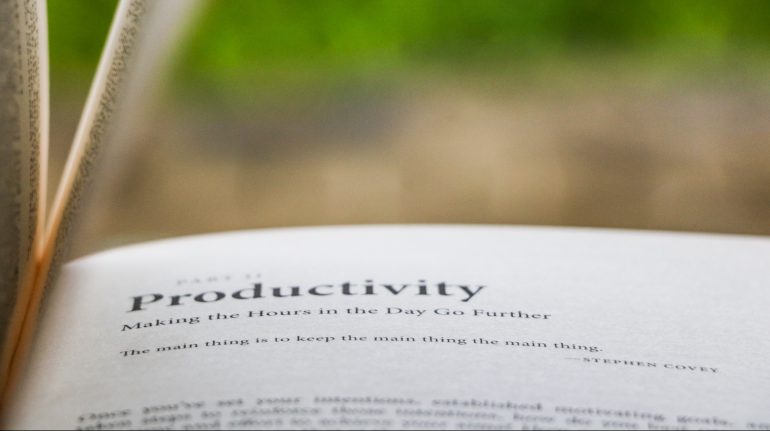For the past few years, and especially throughout college, I’ve seen myself and the people around me struggle to work productively. Even though college students seem to be studying all day long, the transition to a traditional full-time 9am- 5pm workday, 5 days a week, seems even more tedious and exhausting. I’ve always wondered how this work schedule came to be accepted as the societal norm, and if it was even constructed with our biological and mental capacities in mind. For those who (understandably) struggle to work forty hours a week, are more flexible schedules feasible in the workplace–and how would they affect our productivity?
As college students, our lives constantly revolve around the need to optimize our efficiency, struggling to balance deadlines and normalizing unhealthy habits (such as all-nighters). In fact, the race to be the most efficient has led to a culture of ‘toxic productivity’, where people push themselves beyond their physical and mental capacities, and link their self-worth to their productivity. This mindset often leads to mental exhaustion, or burnout. This exhaustive state of mind and body has been labeled as a legitimate mental disorder by the World Health Organization’s International Classification of Diseases 11th revision (ICD-11). It is defined as a “loss of motivation, growing sense of emotional depletion, and cynicism,” often caused by an environment that encourages long hours, unreasonable work demands, and low control and rewards. Biologically, burnout leads to dysfunctional regulation of the neuroendocrine system, which controls hormones in the body. During burnout, the body undergoes stress and releases the stress hormone, cortisol. However, instead of returning back to homeostasis, or a resting state, like it normally would after facing a threat, the body continues to recognize external stressors and maintains a constant release of cortisol. This chronic stress can lead to impairment of “people’s personal and social functioning,” and health problems such as cardiovascular, immune, and memory formation issues. Such lasting physical effects demonstrate that burnout is actually counterproductive for our bodies, our minds, and even our efficiency.
If college students, with our countless hours of work, are already vulnerable to such burnout, the detriments of a lifelong five day, eight hours a day, workweek are unimaginable. This traditional 9 – 5 work schedule is heavily ingrained in our lifestyles, but where does this lifestyle even come from? Does it promote the highest level of focus while allowing us to maintain a good work-life balance?
The 9 -5 workweek began when 19th century industrialist Henry Ford emphasized the need for a two-day weekend for “rest and recreation,” and that such leisure should not be limited to higher income classes. However, this seemingly sympathetic attitude towards the working class masked the industrialists’ true intentions: this two-day respite would allow his workers more time to purchase his own products and services. As a result of Ford’s success, this schedule has propagated through the country from the Industrial Revolution as an effort to promote capitalism, or “the economic system in which private actors own and control property” for profit. However, the growth in productivity over the last few years has been limited to a 1 – 2% annual increase as compared to the past few decades that saw around a 5-10% annual increase. This slowing rise in efficiency can be largely attributed to the aforementioned burnout and toxic productivity. With this in mind, should we continue with the same cookie-cutter understanding of work-life that was developed over 100 years ago? Or is it time we begin shifting towards a more personalized schedule that takes into account our mental and biological limits to maximize our productivity?

Understanding the science behind focus and its relation to productivity may facilitate the shift to this biologically sound approach to efficiency. Focus is defined by the brain’s ability to differentiate between the task at hand and background information. When we are paying attention to a task, neurons responding to the object of focus fire synchronously, whereas those responding to irrelevant information become suppressed. Researcher Robert Desimone further states that focus occurs when that set of neurons “increases the volume” over the other neurons causing general background noise. As a result, a boost in focus and productivity may occur when external, unnecessary distractions are minimized. This scientifically-backed observation may explain why a 4-day work week increases productivity. An extra day off would allow employees more time to accomplish their personal tasks and responsibilities, thereby lessening distractions during the work week. Another phenomena to consider is Parkinson’s Law, a project management model, which states that work takes up the amount of time that is allotted to it. Obviously, a minimum amount of time is necessary to complete any task, but there is a chance that employees may be able to accomplish the same amount of work in fewer days.
In fact, this shortened work week theory was applied to Microsoft employees in Japan–the company offered their employees the option to work 4 days a week while receiving a 5 day week paycheck. The result was a 40% increase in productivity, composed of shorter meetings with less people, unnecessary meetings being replaced with emails and messages, lower use of electricity and on-campus facilities all while outputting the same results as recorded previously. This boost in efficiency indicates that focus and productivity have the potential to be increased with alternate, less intensive schedules that are currently adopted by most workplaces in the United States.
It is extremely interesting to consider that certain social and economical periods of time in our country’s history such as the Industrial Revolution have defined our standards of work-life balance and as a result, productivity in the workplace. Personally, understanding the less sympathetic and health – conscious intentions behind the creation of such standards makes me reconsider how people should approach the idea of efficiency. Especially with the COVID-19 pandemic forcing companies to offer alternative work schedules, I am eager to see the landscape of workplace productivity progress and adapt to our needs so that in the long run, we don’t end up giving in to either capitalism or cortisol. :,)
Sources:
https://www.voicesofyouth.org/blog/toxic-productivity
https://www.psychologicalscience.org/observer/burnout-and-the-brain
https://worldhistoryproject.org/1926/9/25/henry-ford-announces-5-day-work-week
https://mcgovern.mit.edu/2019/03/14/ask-the-brain-how-does-the-brain-focus/
https://pubsonline.informs.org/doi/abs/10.1287/mnsc.37.8.990
https://icd.who.int/browse11/l-m/en#/http://id.who.int/icd/entity/129180281
https://www.epi.org/productivity-pay-gap/
https://www.imf.org/external/pubs/ft/fandd/2015/06/basics.htm

